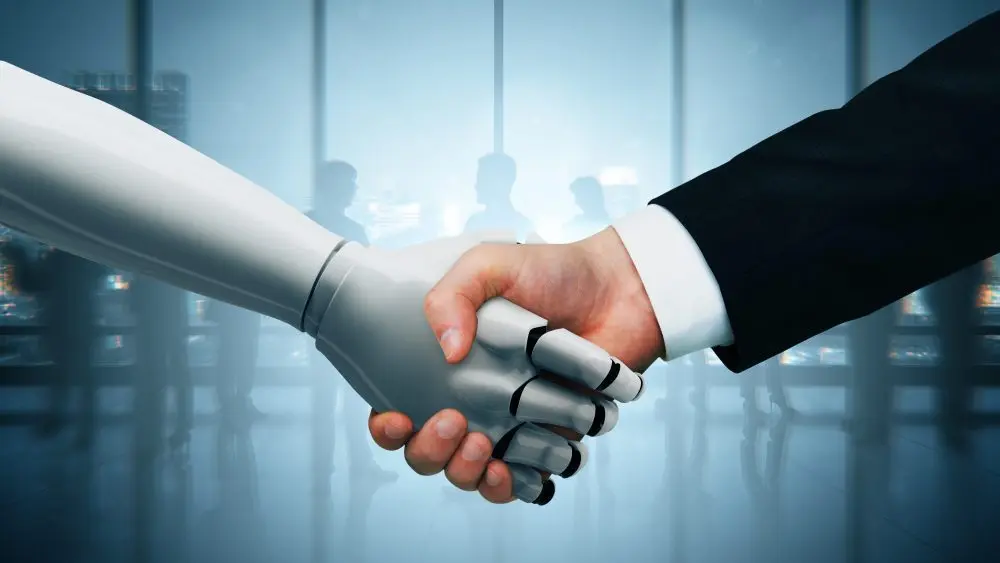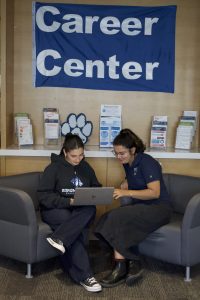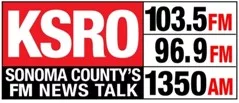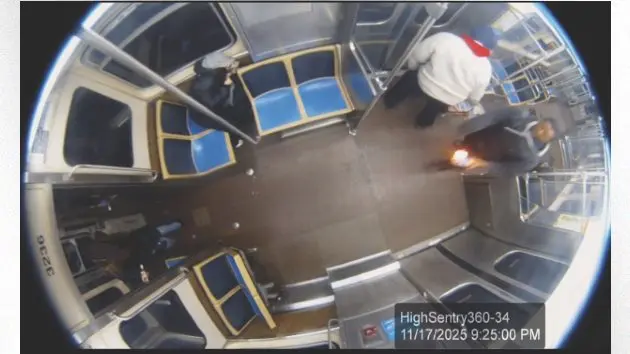
Artificial Intelligence has become a valuable tool for North Bay employers and job seekers, with both now using AI-powered software programs to generate materials like job descriptions and cover letters.
Still, those using AI should be aware of the pitfalls that can come with enlisting bots in the jobs process. Employers, for instance, should be wary of setting preferences that encourage unlawful discrimination in selection. Job seekers, meanwhile, should take care to ensure their application materials are accurate and original.
“In both hiring and applying, the person behind the process is more important than the AI,” says Donaciano Botello Torres, a career advisor at Sonoma State University’s Career Center. “A manager needs to review and OK a job description before it is posted, even if they use AI to generate it. An applicant should review and adjust a resume before they submit it, even if they use AI to refine it.”
SSU’s Career Center is emerging as a local resource in understanding AI’s role in hiring.
So is the set of staffing companies that utilize AI-powered candidate screening software programs. In addition, leaders at local Small Business Development Centers (SBDCs) are hosting and attending AI-centered seminars and workshops to better serve their clients. Earlier this month, the Solano-Napa SBDC hosted North Bay AI for Small Biz Day, a live online event for small to mid-sized businesses to share a clear plan about how to use AI for different purposes.
Miriam Hope Karell, the director of the Marin SBDC, says her takeaway from a recent AI-focused workshop was that businesses should not use only AI to screen and select candidates.
“There are human-centric pieces that are important when choosing candidates. The main point I took away from the discussion is that critical thinking is the number one skill sought after by businesses. Critical thinking cannot be replaced with AI. [It] needs to be developed alongside the use of AI tools,” says Karell.
Karell adds she has seen local business owners be hesitant to use AI-powered software because they are worried about exposing candidates’ personal information.
“There is a concern with using AI and it sharing confidential information about people that should remain private,” says Karell.
AI, the ultimate people pleaser
Without restraints, AI-powered software can lead a company to unknowingly engage in discrimination that violates the California Fair Employment and Housing Act (FEHA) and federal law. This is especially true for employers with a history of selecting against candidates of certain backgrounds. Information in a resume, cover letter, recommendation letter or work sample can indicate a candidate’s nationality, language, age, disability, ethnicity, sex and sexual orientation.
“AI tends to be a people pleaser. It likes to give you what you want, based on past preferences. This is why we use AI to summarize job descriptions. We don’t use it to select candidates,” says Ryan Buxbaum, president of Next One Staffing in Santa Rosa.

Next One Staffing helps recruit and screen candidates for over 100 North Bay employers, primarily in finance, accounting, architecture and Internet services.
“Our own internally developed applicant tracking system (ATS) utilizes AI. But we don’t use an outside system. There are two new bills that California legislators are considering, Assembly Bill 1018 and Senate Bill 7. These would require more oversight and disclosure by employers about the use of AI systems in hiring,” says Buxbaum.
If those bills and others pass, an externally developed ATS could suddenly be outdated. Then it would act in ways that violate state laws.
“This is also why every applicant we are considering for a position gets interviewed by one of our staff members,” says Buxbaum.
Aside from bills in the legislature, new regulations regarding the use of AI in hiring took effect on Oct. 1. These rules were promulgated by the California Civil Rights Council, a body that enforces employment-related state laws. The rules clarify that automated-decision systems (ADSs) may violate California law if they harm applicants or employees based on protected characteristics like gender, race or disability. These regulations also state that automated-decision system assessments like tests or puzzle games that ask questions about a candidate’s disability can constitute an unlawful medical inquiry.
Robert Half, a talent solutions and business consulting firm based in Menlo Park and San Ramon, places greater emphasis on behavioral interviews to uncover real world experience and soft skills.
“In-person or live interviews are becoming more important to assess communication and critical thinking. We’re also coaching hiring teams to look beyond polished resumes and dig deeper into a candidate’s actual qualifications,” says Megan Slabinski, district president for technology for the Bay Area, the Central Valley of California and the Pacific Northwest.
Robert Half has seen an increase in candidates using AI tools to generate resumes and cover letters that closely mirror job descriptions.
“While this can help with keyword optimization, it risks making applications feel generic or inflated. AI-generated materials can get candidates past initial screenings. They often fall short in interviews when the candidate can’t speak to the content authentically,” says Slabinski.

Slabinski says job seekers should use AI to polish materials rather than copy and paste content.
Robert Half has seen issues with AI play out in real-time during virtual interviews. Candidates may type questions into ChatGPT to get “perfect” answers.
“This can be spotted. It often leads to the interview being cut short,” says Slabinski.
As an example of how a local employer uses AI, Kaiser Permanente of Northern California shared with NorthBay biz that it does not use AI to screen candidates or their submissions. It also does not use AI to connect directly with candidates. The company uses AI for tasks like generating outreach messages. It also applies machine learning to recruitment advertising.
Kaiser Permanente added it does not use AI to make decisions about job candidates. It has no current plans to use AI for this purpose.
Examining how SSU sees AI
SSU’s Career Center has three career advisors to assist approximately 5,000 current students and alumni within their first year, post-graduation.
“This is why we teach job seekers to be their own career advisors. Once they understand how to use the AI-powered tools we have, like Jobscan’s AI resume scanner, they are better prepared to work on their own and with us,” says Torres.
Dr. Sarah Ellison is associate vice president for Student Affairs at Sonoma State University. Her office oversees the Career Center. Ellison says advisors explain to students how they can adapt their application materials to applicant tracking systems.
“Job seekers want to avoid terms that will get them ignored or kicked out of AI-powered systems. Some employers also use AI-assisted video interviews,” says Ellison.
This means employers use an AI tool to generate questions and grade responses.
“We help job seekers with this by having them practice with an AI-powered video interview tool. The tool records their answers. The job seekers then watch their videos. They view their score and get feedback on how to respond to certain questions,” says Ellison.

Ellison is interested in hearing from employers as to how students and alumni are faring with applications and in interviews.
Ellison is also a member of the Sonoma County Workforce Investment Board, a group of local stakeholders appointed by the Sonoma County Board of Supervisors to address workforce challenges in the county. “I learn a great deal from this group,” says Ellison. “I consistently look for ways to apply those insights to improve how we prepare our students and graduates for meaningful employment opportunities within Sonoma County and beyond.”
A hands-on how-to
One of the first steps in working with AI tools is to improve formatting. There have been many changes to resumes and application packages in the last few years.
“For example, people don’t put physical addresses on resumes anymore. A lot of jobs don’t require cover letters. This means the resume has to showcase the skills and experiences well. When students first come in, they often add a lot of unnecessary information to their resume,” says Torres.
An AI-generated resume gives a job seeker a “rough draft” of what is standard for their industry.
“Then a student makes an appointment with a career advisor to comb over their resume in a deeper way. We look at the job description. Sometimes the employers use AI to generate it,” says Torres.
Students may be unfamiliar with terms like “leverage” and “agile.” They also may not understand what such terms mean in context.
“That’s when we use AI tools to dissect job descriptions. We enter the job description into ChatGPT to find the top qualities and skills needed for the position. We show that to the student and tell them, ‘Here’s what we want to see in your resume,’” says Torres.
The career advisors often tell students to explain what knowledge they have gained from academic coursework and work experience.
“Rather than state only that you have lab experience, show you know the difference between a wet lab, which involves liquids and biological materials, and a dry lab, which involves data and computer analysis. This better equips the resume to be read by a person and an AI-powered tool,” says Torres.
Torres says job seekers often leave out the projects or internships they completed and the clubs they joined. For example, a recent graduate looking for a job in accounting should state in their resume that they were a member of a campus accounting club for several years. They should also add activities in which they engaged, from fundraising for club trips to volunteer tax assistance every April.
After a student improves their resume, they or a career advisor can use AI-powered software to evaluate the resume. This helps the student know whether their resume will pass initial and subsequent screening processes.
Torres says he and other Career Center advisors continue their own professional development by regularly attending workshops on AI. The National Association of Colleges and Employers develops and offers these workshops.
Other methods of evaluation—and how they tie back to AI
According to Torres, students and recent graduates tend not to ask many questions about AI’s role in hiring processes. This seems to be because they are still learning the benefits of AI and how to use it effectively. But AI can work against job seekers by generating materials that seem “too good of a match.” An over-dependence on AI can lead to candidates presenting one thing on paper and another in interviews.
“We’ve seen cases where candidates land roles based on AI-enhanced resumes but struggle to perform, risking their reputation,” says Slabinski.
Robert Half has addressed this for North Bay winery and tourism-related clients by using a specific interview method called “Situation, Task, Action, Result,” or STAR. STAR interview questions might include “How have you changed the goal of a project?” or “What are some ways you collaborate with team members?”
The answers that job seekers give help showcase their interpersonal skills, ability to provide customer service, and whether they will be a cultural fit for their employer.
Job seekers should be aware that employers may review a candidate’s social media presence to find out more about applicants. There are AI-powered software tools that assist employers with this task.
Torres said students and recent graduates should keep their LinkedIn profile up to date and use it to highlight current activities. He also encouraged students and recent graduates to network online and in person with current and former professors, friends, colleagues and mentors.
“When you share what’s happening in your field and ask about what others are doing, that shows interest and curiosity. It’s a part of who you are. Whether a person or an AI algorithm sees it, exploring your field only helps your job search,” says Torres.




